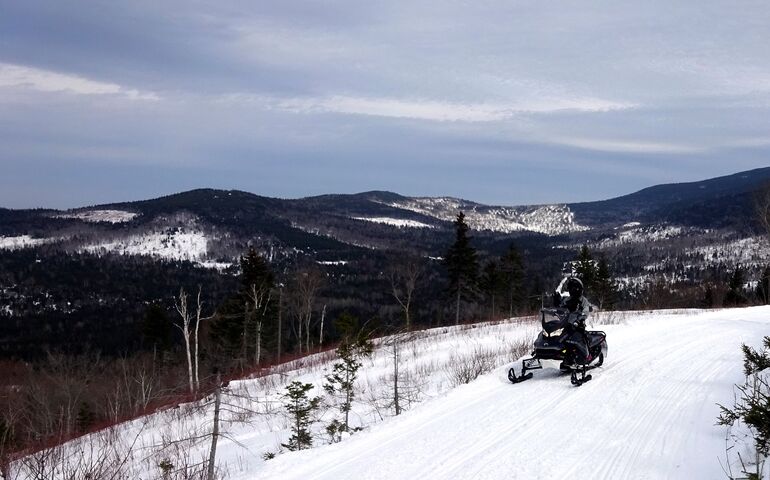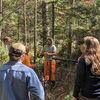Pricier machines, more riders boost Maine snowmobile spending 66%
 Courtesy / Maine Snowmobile Association
The snowmobile industry’s contribution to Maine’s economy has risen 66% over the past two decades, according to a new study.
Courtesy / Maine Snowmobile Association
The snowmobile industry’s contribution to Maine’s economy has risen 66% over the past two decades, according to a new study.
Pricier snowmobiles and more riders, particularly from outside of Maine, have boosted the snowmobile sector's contribution to Maine's economy by two-thirds over the past 20 years.
Always a vital part of Maine's economy, especially in northern regions of the state, snowmobiling generated $459 million in direct spending and supported 2,279 Maine jobs during the 2018-19 season, according to a news release.
Adding indirect and induced economic activity, the contribution of snowmobiling to Maine’s economy was over $606 million, a 66% increase since the sector was last studied in 1998.
The new figures were based on a new economic impact study by the University of Maine, in collaboration with the Maine Snowmobile Association and commissioned by the Snowmobile Program of the Maine Department of Agriculture, Conservation and Forestry’s Bureau of Parks and Public Lands.
The study was led by Ian Hathaway, a master’s student in forest resources, and Jessica Leahy, a professor of human dimensions of natural resources, both in the UMaine School of Forest Resources; and Mindy Crandall, now an assistant professor in forest policy at Oregon State University.
“Having this up-to-date economic impact study is crucial in decision-making,” Joe Higgins, the bureau’s supervisor, said in the release. “With 95% of the 14,000 miles of snowmobile trails being on private property, it is so important that landowners are recognized and that their property is respected. None of this would be possible without their generosity.”
A comparison of the two surveys showed that overall registrations have increased and registrations among nonresidents have more than doubled over the past two decades.
Big-ticket items
During the 1995-96 season, there were 69,000 registered snowmobiles in Maine, 6,500 of which were registered by nonresidents.
In the more recent period, the numbers had grown to over 87,000 registered snowmobiles in Maine with approximately 25,000 registered by nonresidents.
Some of the main factors relating to the greater spending in 2019 are an over-300% increase in out-of-state registrations and the rising costs of big-ticket items such as snowmobiles, which are frequently purchased in Maine, according to the study.
Spending in 2019 has also changed dramatically.
In 1998, snowmobilers spent $250 million when adjusted for inflation. The total contribution, including indirect spending, was $366 million.
In 2019, riders spent $459 million. The total contribution, including indirect spending, was $606 million, an increase of nearly 66%.
The study is available online through UMaine Fogler Library’s Digital Commons.
In addition to direct spending that supports 2,279 jobs, indirect and induced effects support an additional 1,060 jobs. The numbers are especially significant given the impact on rural areas.
Trip-related spending accounted for approximately $209.5 million, or about 46% of total direct spending for the 2018–19 season. Trip-related expenditures include gas and oil for a snowmobile and/or a tow vehicle, restaurant purchases, souvenirs, clothing purchased during the trip and overnight accommodations.
The greatest amount of direct spending in a single category was snowmobile purchases, which generated approximately $132 million in direct spending.
Ridership has grown since the 1998 study, and snowmobiles have become far more expensive, said Leahy.
During the 2018–19 snowmobiling season, more than 61,600 snowmobiles were registered in Maine by resident snowmobilers, and over 25,500 snowmobiles were registered by nonresidents. Since 1998, overall registrations have increased, and registrations among nonresidents have more than doubled.
Top sectors affected by snowmobilers are restaurants, hotels and motels, vehicle and parts sales and repairs, and retail.
Aging demographic
Economic impact data came from survey responses of nearly 900 people with snowmobiles registered in Maine. Nearly 47% of the respondents were from Maine; 53% were from 16 other states — Massachusetts, Rhode Island, New Hampshire, Vermont, Connecticut, New Jersey, New York, Pennsylvania, Virginia, Georgia, Florida, Alabama, Ohio, Michigan, Illinois and Texas.
The survey provided sociodemographic information on snowmobilers. Among the findings:
• The average age of resident and nonresident snowmobilers in Maine is 54 and 53, respectively — a shift from 1998 survey, when the average ages were 42 and 41 for residents and nonresidents, respectively.
• The median annual income grew from $80,000 to $99,999 for resident snowmobilers, and from $120,000 to $149,000 for nonresidents.
• More than 37% of resident and 36% of nonresident snowmobilers own camps or second homes in Maine.
• The majority of resident snowmobilers took their first ride in Maine before 1979; the majority of nonresidents began snowmobiling in the state after 1990. All say they have snowmobiled in Maine annually or more than half the years since their first snowmobile trip in Maine.
The Maine Snowmobile Association is a Maine snowmobilers’ lobbyist group. The updated study can be used as a tool when working on legislative issues in Augusta, Mike Grass Jr., president of the association’s executive committee, said in the release.










0 Comments